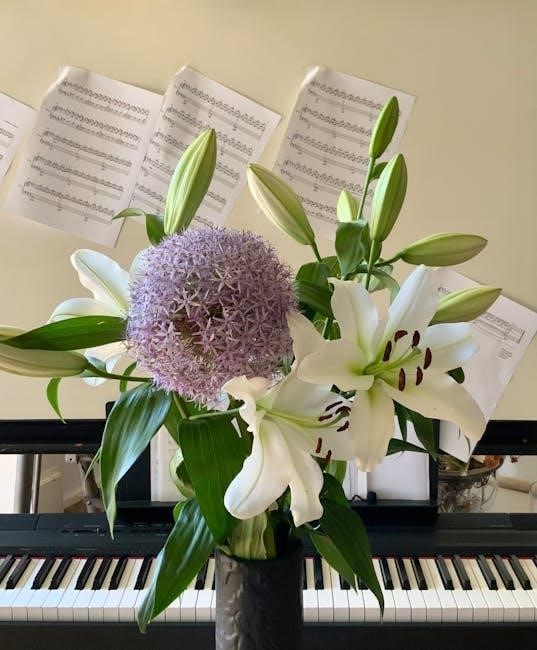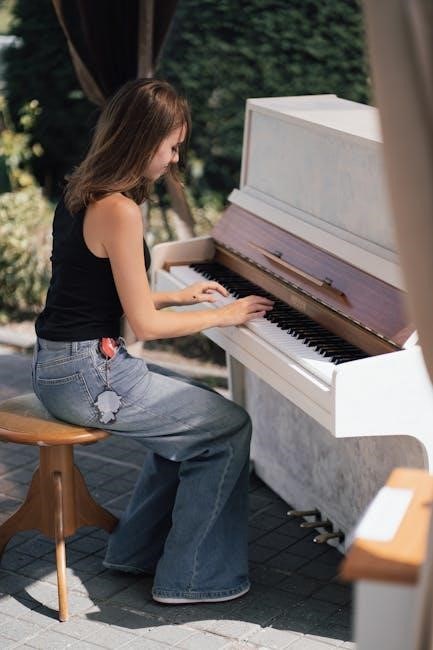The AMEB Piano Syllabus provides a structured learning approach for pianists, offering a comprehensive framework for technical and repertoire development․ Available as a free PDF, it ensures accessibility for students and teachers alike;
Overview of the AMEB Piano for Leisure Syllabus
The AMEB Piano for Leisure Syllabus offers a flexible and engaging approach to piano education, catering to students who wish to explore a wide range of musical styles․ Designed to align with classical principles, the syllabus emphasizes technical proficiency, repertoire diversity, and performance skills․ It includes a variety of genres, from contemporary to musical theatre, allowing students to develop a well-rounded musical understanding․ The syllabus is available as a free PDF download, ensuring accessibility for both students and teachers․ This resource provides detailed requirements for grades, technical work, and repertoire, making it an essential guide for structured learning․ Its focus on vocal technique, theory, and sight-reading further enhances its comprehensive nature, making it a valuable tool for aspiring pianists․
Importance of the AMEB Piano Syllabus for Students
The AMEB Piano Syllabus is a valuable resource for students, providing a clear and structured pathway for musical development․ It ensures a balanced approach to learning, emphasizing technical proficiency, repertoire mastery, and performance skills․ By following the syllabus, students gain confidence in their abilities and develop a deep appreciation for music․ The inclusion of diverse genres, such as classical and musical theatre, broadens their musical understanding․ Additionally, the syllabus’s focus on sight-reading and vocal technique equips students with essential skills for future musical pursuits․ Accessible as a free PDF, it offers convenience and affordability, making high-quality piano education accessible to all․ This comprehensive guide supports students in achieving their full potential, fostering a lifelong love for music and performance․

Understanding the AMEB Piano Syllabus Structure
The AMEB Piano Syllabus is structured into grades, each detailing technical work, repertoire, and performance techniques, ensuring a balanced and progressive learning experience․
Grades and Levels in the AMEB Piano Syllabus
The AMEB Piano Syllabus is divided into eight grades, each representing a progressive level of difficulty․ These grades are designed to cater to students from beginner to advanced levels, ensuring a structured learning path․ Each grade builds on the previous one, introducing more complex techniques and repertoire․ The syllabus also offers options for both classical and leisure piano streams, allowing students to choose their area of interest․ The grades are carefully curated to provide a comprehensive assessment of a student’s technical and musical abilities․ This graded system helps in tracking progress and setting clear goals for pianists․ The availability of the syllabus as a free PDF ensures that all students and teachers can access these resources easily․
Technical Work and Repertoire Requirements
The AMEB Piano Syllabus outlines specific technical work and repertoire requirements for each grade․ Technical work includes scales, arpeggios, and exercises designed to build finger dexterity and strength․ The repertoire selection varies across grades, offering a diverse range of styles and periods, from classical to contemporary pieces․ Students are required to perform a set number of pieces from the syllabus, ensuring a well-rounded musical education․ The free PDF version of the syllabus provides detailed lists of required pieces and technical exercises, making it easy for students and teachers to prepare for exams․ This structured approach ensures that students develop both technical proficiency and artistic expression․
Sight-Reading and Performance Techniques
Sight-reading and performance techniques are integral components of the AMEB Piano Syllabus, aimed at enhancing a student’s ability to interpret and perform music effectively․ The syllabus emphasizes the importance of sight-reading as a skill that fosters musical literacy and spontaneity․ Performance techniques are also meticulously outlined, covering aspects such as dynamics, articulation, and phrasing․ These requirements ensure that students develop a polished and expressive playing style․ The free PDF version of the syllabus provides detailed guidelines and examples, enabling students and teachers to focus on refining these skills․ By mastering sight-reading and performance techniques, students can deliver confident and captivating performances during their exams and beyond․

_accessing the AMEB Piano Syllabus PDF for Free

Accessing the AMEB Piano Syllabus PDF for Free
The AMEB Piano Syllabus PDF is freely available on the AMEB Federal Office website and other official sources, ensuring easy access for students and teachers․ Updated annually․
Official Sources for Downloading the Syllabus
The AMEB Piano Syllabus PDF can be officially downloaded for free from the AMEB Federal Office website, ensuring reliability and accessibility․ Additionally, the AMEB Online Shop provides free access to syllabus resources, including companion texts and guides․ Teachers and students can also find the syllabus on state music education board websites, which often host AMEB materials․ The 2024 syllabus, in particular, has been made available for free download to support widespread adoption․ These official sources guarantee that users receive the most up-to-date and accurate information, essential for exam preparation and teaching․ By utilizing these resources, students and educators can access comprehensive learning materials without additional costs․
Guidelines for Teachers and Students
Teachers and students are advised to thoroughly review the AMEB Piano Syllabus PDF to familiarize themselves with technical work, repertoire, and performance requirements․ Regular practice of sight-reading and technical exercises is essential for exam readiness․ Teachers should encourage students to explore the syllabus’s musical theatre repertoire, fostering a well-rounded musical education․ Utilizing the free companion texts and study materials available online can enhance preparation․ Both teachers and students are encouraged to stay updated with the latest syllabus revisions, such as the 2024 updates, to ensure alignment with current standards․ By following these guidelines, students can achieve optimal performance results and a deeper understanding of the curriculum․
Free Resources and Companion Texts
The AMEB offers a variety of free resources to support piano students and teachers․ Companion texts, such as the Technical Workbook and Grade Books, are available for download alongside the syllabus PDF․ These materials provide detailed exercises, repertoire pieces, and practice guidelines, ensuring comprehensive preparation for exams․ Additionally, the AMEB website features teaching syllabuses and assessment guides, which can be accessed without cost․ These resources are designed to complement the syllabus, offering a structured approach to learning and performance․ By utilizing these free materials, students and teachers can maximize their understanding and mastery of the curriculum, leading to successful exam outcomes and enhanced musical skills․

Key Features of the 2024 AMEB Piano Syllabus
The 2024 AMEB Piano Syllabus introduces revised repertoire, expanded technical requirements, and a stronger focus on performance techniques and music theory․ It also includes new musical theatre additions and updated sight-reading criteria, ensuring a well-rounded educational approach for pianists․
Revisions and Updates in the Latest Syllabus
The 2024 AMEB Piano Syllabus reflects significant updates to align with modern pedagogical standards․ Revisions include expanded repertoire lists, refined technical work requirements, and enhanced performance guidelines․ New additions to the musical theatre repertoire have been introduced, catering to diverse musical interests․ The syllabus also emphasizes improved sight-reading criteria and updated theoretical components․ These changes aim to provide a more comprehensive and engaging learning experience for students․ Additionally, the syllabus is now available as a free PDF, ensuring accessibility for teachers and candidates․ These revisions underscore AMEB’s commitment to fostering musical excellence and adaptability in a changing educational landscape․
New Additions to the Musical Theatre Repertoire
The 2024 AMEB Piano Syllabus introduces exciting new additions to the Musical Theatre repertoire, reflecting contemporary trends and popular demand․ Recent updates include pieces from modern musicals such as Dear Evan Hansen and The Greatest Showman, ensuring a diverse and engaging selection for students․ These additions align with the syllabus’s goal of catering to a broad range of musical interests and skill levels․ The revised repertoire also incorporates feedback from educators and industry professionals, enhancing its relevance and appeal; By incorporating fresh and iconic works, the syllabus encourages students to connect with modern musical styles while maintaining a strong foundation in traditional techniques․ These updates are detailed in the freely available PDF version of the syllabus, making them accessible to all candidates and teachers․
Focus on Vocal Technique and Theory
The AMEB Piano Syllabus emphasizes the integration of vocal technique and theory, particularly in the Piano for Leisure series․ This approach ensures a holistic musical education, blending piano performance with vocal training․ The syllabus encourages students to develop their understanding of music theory, which enhances their ability to interpret and perform repertoire effectively․ Vocal technique is also highlighted, with exercises and pieces designed to improve pitch accuracy, breath control, and expressive delivery․ These elements are seamlessly integrated into the piano curriculum, providing students with a well-rounded skill set․ The free PDF version of the syllabus outlines these requirements in detail, making it an invaluable resource for both students and educators aiming to master both instrumental and vocal aspects of music․ This dual focus fosters versatility and depth in musical proficiency, preparing students for diverse performance opportunities․

Grade-Specific Requirements in the AMEB Piano Syllabus
The AMEB Piano Syllabus outlines distinct requirements for each grade, emphasizing technical work, repertoire, and sight-reading․ These tailored requirements help students and teachers prepare effectively for exams․
Grade 5 Leisure Piano Syllabus Details
Grade 5 Leisure Piano syllabus focuses on advancing technical skills and musical interpretation․ Students are required to perform a selection of repertoire pieces, including classical and contemporary works․ Technical exercises and scales are also assessed, ensuring a well-rounded musical foundation․ Sight-reading is integral, testing the candidate’s ability to play unfamiliar pieces with accuracy․ The syllabus encourages a balance between technical proficiency and artistic expression, preparing students for higher grades while fostering a love for diverse musical styles․ The free PDF download of the syllabus provides comprehensive details, making it an essential resource for both students and educators․
Technical Work for Grade 5
Technical work for Grade 5 in the AMEB Piano Syllabus focuses on building foundational skills such as scales, arpeggios, and chord progressions․ Students are required to demonstrate accuracy, control, and rhythmic precision․ The syllabus specifies that scales must be played in both hands, with particular attention to finger dexterity and evenness of tone․ Chromatic scales and contrary motion exercises are introduced at this level, enhancing technical versatility․ Additionally, students must prepare selected technical exercises from the AMEB Grade 5 Technical Work book, which is available as part of the free PDF syllabus․ These exercises are designed to strengthen specific aspects of piano technique, ensuring a solid foundation for advanced studies․ Regular practice of these technical requirements is essential for success in the examination․
Repertoire Selection for Grade 5
The Grade 5 AMEB Piano Syllabus emphasizes a diverse range of repertoire, encouraging students to explore various musical styles and periods․ The syllabus includes a selection of classical, romantic, and contemporary pieces, as well as arrangements of popular and musical theatre works․ Students are required to prepare a balanced program, showcasing their ability to interpret different genres․ The 2018 revisions introduced new repertoire pieces, including modern compositions and musical theatre additions, to cater to diverse musical interests․ The syllabus, available as a free PDF, provides detailed lists of approved works, ensuring students and teachers have clear guidance․ This structured approach helps students develop expressive and technical skills, preparing them for a polished performance in their examination․

Preparation and Resources for the AMEB Piano Exam
The AMEB Piano Syllabus PDF offers free access to detailed requirements, technical workbooks, and grade-specific resources, aiding students in effective preparation and technical skill development․
Recommended Study Materials and Grade Books
The AMEB Piano Syllabus PDF provides detailed study materials, including grade-specific books and technical workbooks․ These resources align with the syllabus requirements, ensuring comprehensive preparation․ Students can access AMEB Series 15, Series 16, and the 2019 Piano Series 18 grade books, which complement the syllabus․ Technical workbooks are essential for mastering scales, arpeggios, and other exercises․ Additionally, the syllabus guides students on sight-reading and performance techniques․ Teachers and students can download free companion texts and teaching resources from the AMEB Federal Office website․ These materials are designed to support structured learning and effective exam preparation, covering all aspects of the syllabus․
Role of Sight-Reading in the Examination
Sight-reading holds a significant place in the AMEB Piano examination, assessing a candidate’s ability to interpret and perform unseen music․ The syllabus emphasizes its importance, requiring students to demonstrate fluency and accuracy․ The Piano for Leisure series, revised in 2018, integrates sight-reading as a core component, alongside technical work and repertoire․ Candidates are expected to sight-read pieces that reflect the style and difficulty appropriate to their grade level․ This skill is crucial for developing overall musicianship and performance confidence․ The AMEB syllabus provides guidelines and resources to help students and teachers prepare effectively, ensuring they meet the examination standards․ Sight-reading is thus a vital part of the assessment, contributing to a well-rounded musical education․
Performance Tips for Optimal Results
Optimal performance in the AMEB Piano examination requires careful preparation and attention to detail․ Understanding the exam criteria and practicing with a metronome can enhance timing and rhythm․ Regular practice sessions, including scales and arpeggios, improve technical accuracy․ Developing a pre-performance routine can help manage nerves and maintain focus․ Recording practice sessions allows for self-assessment and refinement․ Familiarity with the exam venue and piano ensures comfort during the performance․ Seeking feedback from teachers and incorporating it into practice fosters growth․ A well-balanced repertoire selection, as outlined in the syllabus, demonstrates versatility and mastery․ By adhering to these strategies, candidates can deliver polished and confident performances, maximizing their potential for success in the examination․

Recent Updates and Changes in the Syllabus
Recent updates to the AMEB Piano Syllabus include the 2018 revision of the Piano for Leisure series and the 2024 syllabus, adding new repertoire and technical requirements․
2018 Revisions in the Piano for Leisure Series
The 2018 revisions in the Piano for Leisure series introduced significant changes, aligning it more closely with the classical syllabus․ New repertoire pieces were added, reflecting contemporary styles and expanding musical diversity․ Technical work was refined to enhance performance skills, while sight-reading became a more integral part of the assessment․ These updates ensured the syllabus remained relevant and engaging for modern pianists․ The revised syllabus also emphasized the importance of vocal technique and theory, providing a well-rounded educational framework․ Teachers and students benefited from these changes, which aimed to foster artistic growth and technical proficiency․ The updates were widely embraced, marking a new era in piano education․
2020 Updates and Their Impact on Candidates
The 2020 updates to the AMEB Piano Syllabus introduced new repertoire pieces, including contemporary and musical theatre works, enhancing diversity in musical styles․ These changes provided candidates with fresh performance options, aligning with modern musical trends․ Technical work and sight-reading requirements were also refined, focusing on improving practical skills․ The updates emphasized the integration of vocal technique and theory, ensuring a holistic musical education․ Candidates benefited from these revisions, as they encouraged a broader range of musical expression and technical proficiency․ The updates also prompted teachers to adapt their teaching methods, ensuring students were well-prepared for the evolving demands of the syllabus․ Overall, the 2020 updates enriched the learning experience, offering candidates a more dynamic and comprehensive framework for growth․

2024 Syllabus Publication and Its Significance
The 2024 AMEB Piano Syllabus marks a major milestone, being the first comprehensive revision since 2008․ This update introduces significant changes, including new repertoire pieces, updated technical requirements, and a stronger emphasis on contemporary musical styles․ The syllabus reflects current pedagogical practices, ensuring it remains relevant for modern pianists․ Its publication underscores AMEB’s commitment to providing a dynamic and inclusive framework for musical education․ The 2024 syllabus also highlights the importance of vocal technique and theory, offering a well-rounded approach to piano studies․ As a free PDF, it remains accessible to students and teachers worldwide, fostering a community of learners who can benefit from its enhanced structure and content․

Benefits of Using the AMEB Piano Syllabus
The AMEB Piano Syllabus offers a structured learning path, enhancing technical and performance skills․ It provides comprehensive assessment and feedback, ensuring measurable progress for pianists of all levels․
Structured Learning Path for Pianists
The AMEB Piano Syllabus provides a well-organized learning path, guiding pianists from beginner to advanced levels․ Each grade builds on the previous, ensuring steady progress in technical skill and musical understanding․ The syllabus is designed to cater to diverse learning styles, offering a balance of repertoire, technical work, and performance techniques․ By following the structured framework, students develop a strong foundation in piano playing, preparing them for both recreational enjoyment and professional pursuits․ The availability of the syllabus as a free PDF ensures accessibility, allowing teachers and students to plan and track progress effectively․
Enhanced Performance and Technical Skills
The AMEB Piano Syllabus emphasizes the development of both performance and technical skills, ensuring a holistic approach to piano education․ Students are encouraged to refine their technique through scales, arpeggios, and other exercises, while repertoire selections foster artistic expression․ Sight-reading and performance techniques are integral components, helping students adapt to various musical styles and genres․ The syllabus’s structured progression allows for a steady improvement in dexterity, accuracy, and musicality․ By mastering these elements, pianists gain confidence and the ability to deliver polished performances․ The free PDF syllabus provides clear guidelines, enabling teachers to tailor lessons effectively and students to track their advancement in both technical proficiency and artistic interpretation;
Comprehensive Assessment and Feedback
The AMEB Piano Syllabus incorporates a detailed assessment framework, offering constructive feedback to students․ Exams evaluate technical work, repertoire performance, and sight-reading, ensuring a well-rounded evaluation․ The syllabus provides clear criteria for each grade, allowing students and teachers to understand expectations; Feedback from examiners highlights strengths and areas for improvement, guiding students toward achieving their full potential․ This structured approach ensures continuous growth and refinement of skills․ The availability of the syllabus as a free PDF enables easy access to assessment guidelines, fostering transparency and consistency in the evaluation process․ This comprehensive system supports students in their musical journey, preparing them for future challenges and opportunities in piano performance․
The AMEB Piano Syllabus offers a structured learning path, enhancing technical and performance skills․ Its free PDF availability ensures accessibility for all, fostering musical excellence and growth․
Final Thoughts on the AMEB Piano Syllabus
The AMEB Piano Syllabus is a cornerstone for pianists, offering a structured and comprehensive approach to learning․ Its availability as a free PDF ensures accessibility for all students and educators, promoting widespread musical development․ The syllabus’s emphasis on technical proficiency, diverse repertoire, and performance techniques equips pianists with the skills needed to excel in their musical journeys․
With regular updates, such as the 2018 and 2020 revisions, the syllabus remains relevant and aligned with contemporary musical standards․ Teachers and students alike benefit from its clear framework, which fosters growth and creativity․ The AMEB Piano Syllabus continues to be an invaluable resource, shaping the next generation of pianists with its rigorous yet nurturing approach to music education․
Encouragement for Students and Teachers
Embrace the AMEB Piano Syllabus as a powerful tool for musical growth․ Students, leverage the free PDF resources to explore a structured learning path, while teachers utilize the comprehensive framework to guide their instruction․ The syllabus’s focus on technical skill, repertoire diversity, and performance techniques provides clear goals for progression․ By aligning with the syllabus, students can confidently prepare for exams and develop a lifelong passion for music․ Teachers will find the syllabus a valuable ally in fostering creativity and technical excellence․ Stay updated with the latest revisions and resources to maximize your musical journey․ Remember, the AMEB Piano Syllabus is not just a guide—it’s a gateway to achieving musical excellence and personal growth․



